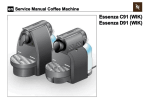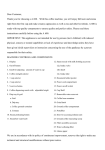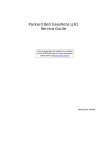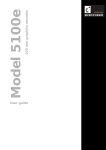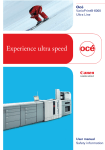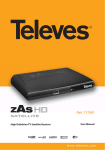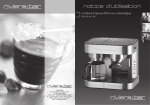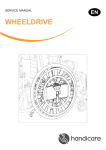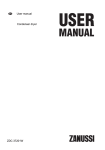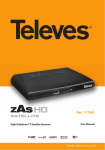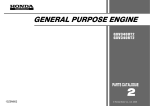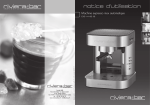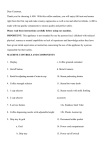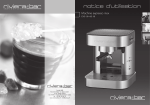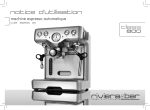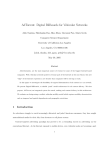Download 2 - BuySpares
Transcript
en Service Manual Coffee Machine Essenza EF 347 / C99 Essenza EF 348 / D99 Version 1.0 en Contents Preface______________________________________________ 3 Replacing thermoblock ________________________________ 23 Replacing pump______________________________________ 24 Replacing electronic control board with button prints _________ 25 Replacing compact brewing unit _________________________ 26 Wiring diagram 220V - 240V IEC_________________________ 27 Wiring diagram 120V - 127V IEC_________________________ 28 General _____________________________________________ 3 Nespresso technical website_____________________________ 3 Content updates ______________________________________ 3 General Safety Notes ________________________________ 4 Main Components ___________________________________ 5 Overview ____________________________________________ Overview of rating plates________________________________ Rating Plates - Essenza machine partners __________________ Water circuit _________________________________________ Function Tests ______________________________________ 29 5 6 7 8 Safety instructions ____________________________________ 29 Measuring flow rate (1) ________________________________ 30 Measuring flow rate (2) ________________________________ 31 Checking for leaks and pump pressure (1) _________________ 32 Checking for leaks and pump pressure (2) _________________ 33 Measuring coffee temperature___________________________ 34 Protective earth continuity test (1) ________________________ 35 Protective earth continuity test (2) ________________________ 36 Protective insulation test (1) ____________________________ 37 Protective insulation test (2) ____________________________ 38 Protective insulation test (3) ____________________________ 39 Technical Data_______________________________________ 9 Operation __________________________________________ 10 Making coffee _______________________________________ Programming the water system__________________________ Emptying the water system _____________________________ Energy saving mode __________________________________ Reset to factory settings _______________________________ Coffee machine status (1) ______________________________ Coffee machine status (2) ______________________________ 10 11 12 13 14 15 16 Maintenance ________________________________________ 40 Descaling (1) ________________________________________ 40 Descaling (2) ________________________________________ 41 Troubleshooting ____________________________________ 17 Spare Parts _________________________________________ 42 Check Machine on receipt______________________________ 17 Repair accessories ___________________________________ 42 Spare parts EF 347 / C99 ______________________________ 43 Spare parts EF 348 / D99 ______________________________ 46 Repair ______________________________________________ 20 Safety instructions ____________________________________ 20 General disassembly__________________________________ 21 Replacing NTC ______________________________________ 22 Service Manual EF 347 / EF 348 2 Version 1.0 en Preface General Nespresso technical website The purpose of this service manual is to provide the service personnel with all necessary information with regards to correct handling, maintenance and repair of the coffee machines EF 347 and EF 348. Visit the Nespresso technical website periodically to check for upgrades, technical modifications, counter measures etc. for this coffee machine: https://business.nespresso.com This manual should be used by the technicians as a valuable aid to guarantee the permanent readiness for use of the machine. In order to take full advantage of all the functions, it is absolutely necessary to follow the instructions in this manual. Service Manual EF 347 / EF 348 Access is restricted and can be obtained by asking your Nespresso technical contact person. Content updates The version number of this service manual is printed on the lower right corner of the page. Version 1.0 First released service manual version. Please keep this manual together with the corresponding service documentation. This way you are assured to have the necessary information. 3 Version 1.0 en General Safety Notes • • • Risk of fatal electrical shock and fire! Mains voltage inside the coffee machine. Unplug appliance before cleaning. Never clean wet or immerse plug, cord or appliance in any fluid. Disconnect the mains plug before disassembly - the appliance must be free of voltage. Example illustrations of typical devices: 1 RESET 2 TEST As an additional safety measure, the use of a residual current device (RCD), also called a ground fault circuit interrupter (GFCI), in the repair centre is highly recommended. 3 This device does not protect against electrical shock due to contact with both circuit conductors. RESET 4 Use a GFCI with a trip level of 4 - 6 mA (USA) resp. a RCD with a trip level of 15 - 30 mA (Europe). A trip level above 30 mA provides only very limited protection against harm from an electric shock. • Danger of burns! Hot parts and water under pressure inside the coffee machine (particularly in the thermoblock). Let coffee machine cool down before cleaning or disassembly. Service Manual EF 347 / EF 348 1) 2) 3) 4) TEST RCD protected socket-outlet Plug-in RCD unit GFCI socket Plug-in GFCI 4 Version 1.0 en Main Components Overview 1) 2) 3) 4) 5) 6) 7) 8) 9) 10) 11) 12) 13) 14) 15) 16) 17) Closing handle Cover Compact brewing unit (TCBU) Capsule inlet Side panel Espresso button, back lighted Coffee outlet Lungo button, back lighted Container for used capsules Drip grid Drip tray Lower chassis Thermoblock Electronic control board Pump Upper chassis Water tank 10 1 2 9 11 3 4 6 17 7 8 5 16 14 12 15 13 Service Manual EF 347 / EF 348 5 Version 1.0 en Main Components Overview of rating plates The rating plate can be found at the underside of the coffee machine. It is of varying design depending on the brand and carries the following information: 1. 2. 3. 4. 5. 6. 7. 8. 9. 10. Brand name Voltage and power rating Manufacturing country Conformity with RoHS guidelines Bar code Serial number Machine type Special disposal icon Sign of conformity (CE) Article number of the rating plate 1 7 2 3 8 4 9 5 10 6 Serial number codification Example: 121 243 47Q 1234 782 1Ke 12124 347 Q 1234 7 8 2 1K e production date: 124th day of year 2012 machine type (EF no.) production site incremental number per production day machine partner codification voltage mains plug version colour version checksum number Service Manual EF 347 / EF 348 6 Version 1.0 en Main Components Rating Plates Essenza machine partners Service Manual EF 347 / EF 348 7 Version 1.0 en Main Components Water circuit 1) 2) 3) 4) 5) 6) 7) Water tank Water tank valve and connector Pump Thermoblock Flowmeter Coffee outlet Compact brewing unit (TCBU) 7 6 1 5 2 3 4 Service Manual EF 347 / EF 348 8 Version 1.0 en Technical Data Mains EF 347 291 EUR USA / CAN Approvals mm 254mm Cable length 230V / 50 Hz 120V / 60 Hz SEV, CENELEC, CE-conform UL, CUL, MITI approx. 1.5 m 260mm Energy efficiency class level Daily energy consumption Annual energy consumption A - 40% 63.8 Wh 23.3 kWh Various data Pump data 166 EF 348 Energy consumption (CECED / FEA 2009 method) Pump pressure - max. permissible 17,5 bar ± 1,5 bar - during coffee preparation 9 - 13 bar (depending on brand of coffee) mm 291 Flow performance 120 - 240 ml/min. at 12 bar mm Pre-heating time approx. ~25 sec. Storage temperature -25° C up to 60° C Safety temperature (thermal cut-off) 167° C Coffee temperature at outlet 86° C ± 3° C Weight of machine (without water) approx. 3 kg Capacities 254 mm 260mm 166 mm Water tank Drip tray Capsule container 0.9 l approx. 100 ml 10 - 14 pcs. Power consumption 220 V / 240 V Service Manual EF 347 / EF 348 1’260 W 9 Version 1.0 en Operation Making coffee 1 2 1. Rinse then fill the water tank with potable water. 2. a) Press the Espresso or Lungo button to activate the machine. b) Blinking Lights: heating up (25 sec). Steady Lights: ready. a Never lift lever during operation and refer to the safety precautions to avoid possible harm when operating the appliance. During heat up, you can press either coffee button while blinking. The coffee will then flow automatically when the machine is ready. 3. Lift the lever completely and insert a Nespresso capsule. 4. Close the lever and place a cup under the coffee outlet. 5. Press the Espresso (40 ml) or the Lungo (110 ml) button to start. Preparation will stop automatically. To stop the coffee flow or top up your coffee, press again. 6. Remove the cup. Lift and close the lever to eject the capsule into the used capsule container. Service Manual EF 347 / EF 348 4 3 10 5 b 6 Version 1.0 en Operation Programming the water system 1. Turn the machine on and wait for it to be in ready mode (steady lights). 2. Fill the water tank with potable water and insert a Nespresso capsule. 3. Place a cup under the coffee outlet. 4. Press and hold the Espresso or Lungo button. 5. Release button once the desired volume is served. 6. Water volume level is now stored. 2 1 3 Service Manual EF 347 / EF 348 4 11 Version 1.0 en Operation Emptying the water system 1 2 3 4 The machine will be blocked for 10 minutes after emptying mode. 1. To enter the emptying mode, press both the Espresso and Lungo button to turn the machine off. 2. Remove the water tank and open the lever. 3. Press both the Espresso and Lungo button for 3 seconds. a) Both LEDs blink alternatively. 4. Close the lever. 5. Machine switches off automatically. 6. Empty and clean the used capsule container and drip tray. a Service Manual EF 347 / EF 348 12 Version 1.0 en Operation Energy saving mode 1 2 3 4 5 6 This machine is equipped with an energy saving feature. The machine will automatically enter power off mode after 9 minutes. 1. To turn the machine on either press the Espresso or Lungo button. 2. To turn the machine off before automatic Power Off mode, press both the Espresso and Lungo button simultaneously. To change this setting 3. With machine being turned off, press and hold the Espresso button for 3 seconds. 4. The Espresso button will blink to indicate the current setting. 5. To change this setting press the Espresso button: One time for power off mode after 9 minutes One more time for power off mode after 30 minutes One more time to deactivate 6. To exit the energy saving mode press the Lungo button for 3 seconds. Service Manual EF 347 / EF 348 13 Version 1.0 en Operation Reset to factory settings 1 2 1. With machine being turned off, press and hold down the Lungo button for 5 seconds. 2. LEDS will blink fast 3 times to confirm machine has been reset to factory settings. 3. LEDs will then continue to blink normally, as heating up, until ready. Steady lights: machine ready 3x Factory settings: Espresso Cup: 40 ml Lungo cup: 110 ml Power off mode: 9 min. 3 Service Manual EF 347 / EF 348 14 Version 1.0 en Operation Coffee machine status (1) After pressing the On/Off button, an automatic self test is performed to check if - the NTC is connected, - the NTC is short circuited, - the thermoblock reaches the standby temperature within 2 minutes. Operating modes and detected failures are indicated by backlighted coffee buttons as listed in the following table. Service Manual EF 347 / EF 348 ) Led signal LED signal Operating mode Small cup Off off off Ready on on Error blinking fast 3 times every 2 sec. blinking fast 3 times every 2 sec Heat up Blinking slow Blinking slow Brewing small cup Blinking slow on Brewing big cup on Blinking slow Rinse small cup Blinking slow on Rinse big cup on Blinking slow 15 Big cup Version 1.0 en Operation Coffee machine status (2) ( 1 H z Led signal Operating mode Small cup Big cup off Power off Program Blinking small cup - 1x for 9 min. (factory setting) - 2 x for 30 min. - 3 x for deactivated Blinking fast off off Blinking fast Descaling ready D. pump on descal) D. pump off (descal) Blinking fast Blinking fast Overheat Blinking slow Blinking slow Order small cup (during heat) Blinking slow off LED signal Emptying Service Manual EF 347 / EF 348 Order big cup (during heat) off Blinking slow No more stand by No more power save - - Resetting to factory Blinking 3 Hz Blinking 3 Hz 16 Version 1.0 en Troubleshooting Check Machine on receipt The receipt check enables you to rapidly locate faults on the machine and to initiate appropriate repair action. Check procedure 1 Check appliance for visible damage Follow the check procedure. Repair any faults found and check if the machine is operating perfectly. Symptoms Action / repair work 1.1 Parts of housing broken or damaged YES - Replace parts if necessary NO - Go to point 1.2 1.2 Mains cable damaged YES - Replace mains cable NO - Plug machine to the mains and go to point 2.1 Further action / repair work YES - Go to point 2.2 2.1 Closing handle works correctly 2 Check mechanical elements 3 Fill water tank YES - Screw on closing handle screws at defined NO - It is hard or impossible to close the closing handle torque or replace CBU (see page 26) NO - Replace the CBU 2.2 Is the capsule correctly ejected? YES - Go to point 3 NO - Replace TCBU 3.1 Water tank is leaking YES - Replace water tank NO - Go to point 4 Service Manual EF 347 / EF 348 17 Version 1.0 en Troubleshooting Check procedure 4 Press any button to start coffee machine to perform automatic self test Symptoms 4.1 Machine is not working (no function) Action / repair work Further action / repair work YES - a) Check if mains cable is functional YES - Go to point b) NO - Replace it YES - c) Check if pump is working (press coffee button) YES - Go to point f) NO - Go to point d) YES - d) Check if coffee button is functional YES - Go to point e) NO - Replace it YES - e) Check if pump's thermal fuse (128°C) is defective YES - Replace pump (see page 24) NO - Go to point f) YES - f) Check if thermoblock’s thermal fuse (167°C) is defective YES - Replace thermal fuse and if necessary thermoblock too (see page 23) NO - Go to point g) YES - g) Check if electrical wires are functional YES - Replace elect. mainboard and the NTC (see page 25) NO - Replace defective(s) wire(s) NO - Go to point 4.2 YES - Check if thermoblock heating element is func4.2 Backlighted coffee button blinks at irregular tional intervals NO - Self test ok. Go to point 5 5.1 No coffee at outlet 5 Check coffee temperature while preparing a coffee (see page 34) YES - Replace NTC (see page 22) NO - Replace thermoblock (see page 23) YES - a) Water system is empty YES - Fill water system (see page 11) NO - Go to point b) YES - b) Pyramid plate is clogged YES - Replace TCBU (see page 26) NO - Go to point c) YES - c) Machine is blocked by scale YES - Descale machine (see page 40) NO - Go to point 5.2 5.2 Temperature is too low (less than 83°C) YES - Descale the machine (see page 40) NO - Go to point 5.3 5.3 Temperature is too high (more than 89°C) YES - Change NTC (see page 22) NO - Go to point 6 Service Manual EF 347 / EF 348 18 Version 1.0 en Troubleshooting Check procedure Symptoms 6.1 Leakage at extraction system 6 Check for leaks and check flow 6.2 Leakage at tubes connection rate (see pages 28 and following) 7 Descaling process (if needed) Action / repair work Further action / repair work YES - Replace TCBU (see page 26) NO - Go to point 6.2 YES - Replace defective tube and seal NO - Go to point 6.3 6.3 Flow rate out of range YES - Machine is scaled 7.1 Machine scaled YES - Descale machine (see page 40) NO - Go to point 8 YES - Descale machine (see page 40) NO - Replace pump 8 Final cleaning End of check procedure Service Manual EF 347 / EF 348 19 Version 1.0 en Repair Safety instructions Risk of fatal electrical shock! Mains voltage inside the coffee machine. Disconnect the mains plug before disassembly - the coffee machine must be free of voltage. Danger of burns! Hot parts and water under pressure inside the coffee machine (thermoblock in particular). Let coffee machine cool down before disassembly. Service Manual EF 347 / EF 348 20 Version 1.0 en Repair General disassembly Tool: - 5 Oval screwdriver 33 Procedure: 1. Remove water tank (33) and drip tray (8) together with drip grid (7) and capsule container (6). 2. Remove 2 screws (2) on the front side of the machine. 3. Place machine on the repairing/service holder device (see page 42). 4. Remove 6 screws (2) on the bottom of the machine. 5. Swing out and remove both side panels (5). 6. Remove lower chassis (22). 22 2 5 6+7+8 2 Service Manual EF 347 / EF 348 21 Version 1.0 en Repair Replacing NTC Tools: - Torx screwdriver Pin-TX10 Open-ended spanner 9 mm AF Torque wrench Procedure: 1. Follow general disassembly (see page 21). 2. Unplug NTC connector from electronic control board (A). 3. Unscrew 3 screws (23) from thermobloc cover. 4. Unscrew the screw fixing the cover to the thermobloc and remove the cover. 5. Remove defective NTC temperature sensor (43) from thermoblock (40) and replace it with a new one. 6. Assemble in reverse sequence. Re-use spring lock washer (42) and tighten new NTC temperature sensor (43) with torque wrench (80 - 100 Ncm). A 23 43 42 40 23 23 Service Manual EF 347 / EF 348 22 Version 1.0 en Repair Replacing thermoblock Tools: - Torx screwdrivers Pin-TX10, TX20 Open-ended spanner 9 mm AF Torque wrench Procedure: 1. Follow general disassembly (see page 21). 2. Remove 3 screws (23) and separate thermoblock assembly from upper chassis (1). 3. Unplug NTC connector from electronic control board (28). 4. Remove clips (D) and 2 hose connectors (B + C) from thermoblock. 5. Remove ground wire and electrical connections from thermoblock. 6. Replace thermoblock (40) 7. Mount a new NTC temperature sensor (43) on the thermoblock (40). 8. Assemble in reverse sequence. B D 40* 28 40* 43 1 Use a torque wrench (80 - 100 Ncm) to tighten NTC temperature sensor (43) with spring lock washer (42). 40* A 40* 23 * (complete thermoblock group) Service Manual EF 347 / EF 348 23 Version 1.0 en Repair Replacing pump Tools: - Torx screwdriver Pin-TX10 Long-nose pliers Blade screwdriver, no. 7 T 128°C Procedure: 1. Follow general disassembly (see page 21). 2. Remove clip (14) and O-ring (15). 3. Remove pump (17). 4. Remove electrical connections from pump. 5. Replace defective pump (17). 6. Plug in electrical connections on pump. L Check for correct wiring of pump. 7. Insert new O-ring (15). 8. Mount angled hose (26) with clip (14). 14 26 15 Service Manual EF 347 / EF 348 24 17 Version 1.0 en Repair Replacing electronic control board with button prints Tools: - Torx screwdriver Pin-TX10 The service engineer must be earthed using an earthing strap! 35 28 Only touch button prints with dedicated gloves to avoid oxydation. Procedure: 1. Follow general disassembly (see page 21). 2. Remove 2 screws (55) and remove housing (A) from electronic control board. 3. Unplug NTC and flowmeter and all wires from electronic control board (28). 4. Remove the 2 screws (23) from cover (35), open the lever (37) and lift up lightly the front part of the cover so the buttons prints wires can pass. 5. Replace defect electronic control (B) board with button prints (B). 6. Assemble in reverse sequence. 37 23 55 B A Check for correct wiring of electronic control board (see page 27). Service Manual EF 347 / EF 348 25 Version 1.0 en Repair Replacing compact brewing unit Tools: - Torx screwdriver Pin-TX10 Blade screwdriver no. 4 Long-nose pliers Torque wrench 44 Procedure: 1. Remove water tank (33) and drip tray (8) together with drip grid (7) and capsule container (6). 2. Place machine on the repairing/service holder device (see page 42). 3. Remove 4 screws (2) on the bottom of the machine. Swing out and remove both side panels (5). 4. Remove 2 screws (36) and pull off closing handle (37). 5. Remove 2 screws (23) at the front and 1 screw (44) at the back to detach cover (35). C99 machine: All screws have the same lenght. D99 machine: The screw at the back is longer than those at the front. 6. Remove clip (14) and hose (32) with Oring (15) from compact brewing unit. Service Manual EF 347 / EF 348 2 34 35 24 5 36 14 37 36 15 23 3 7. Unlatch coffee outlet (3) from compact brewing unit (34) with a blade screwdriver. Take care not to damaged the ring, otherwise replace it 8. Remove 4 screws (24) and detach compact brewing unit (34). 26 32 Tighten closing handle screws (21) with a torque of 230 - 270 Ncm. Version 1.0 en Repair Wiring diagram 220V - 240V IEC Service Manual EF 347 / EF 348 27 Version 1.0 en Repair Wiring diagram 120V - 127V IEC Service Manual EF 347 / EF 348 28 Version 1.0 en Function Tests Safety instructions Some function tests are performed with an energized, partly opened coffee machine. 2 1 Danger of electrocution! Mains voltage inside the coffee machine. Do not touch any live part while performing tests. Danger of burns! Hot parts and water under pressure inside the coffee machine. Do not touch any hot parts while checking for leakages! Always wear protective goggles. 3 T2 T1 Required equipment Pos. Component 1 Pressure gauge (EFR no. 16195) 2 Essenza pressure gauge adapter (for part number refer to EF webshop) 3 Electronic thermometer (or digital multimeter suitable for temperature measurement) 4 Timer 5 Measuring beaker 6 Test equipment for protective earth continuity test and protective insulation test Service Manual EF 347 / EF 348 4 1 RE HO L SUR E P COM 0Ω A OP K/ST DJ T LIGH LOC °C/° F E MEA MIN T1 T1← T2 T2 NG 6 LD MAX RA 5 -200 -328 °C 13 °F - 24 70°C 98°F 29 Version 1.0 en Function Tests Measuring flow rate (1) Procedure: 1. Fill and insert water tank. 2. Open closing handle. 3. Insert connecting unit of pressure adapter into capsule bay. 4. Push back sealing cone into capsule cage. 5. Insert fixation unit of pressure adapter into capsule bay. 6. Press down operating lever. 2 1 3 6 Continued on next page. Service Manual EF 347 / EF 348 30 Version 1.0 en Function Tests Measuring flow rate (2) Procedure (continued): 30 sec 7. Connect pressure hose to pressure tester. 8. Position measuring beaker underneath exit tube of pressure tester. 9. Switch on machine. 10. Press coffee button after heating-up. 11. Open valve fully till water begins to flow. 12. Close valve slowly until 12 bar are indicated. The manometer must be observed continuously and the pressure regulated using the valve if necessary. With increasing temperature the pressure also increases, if necessary readjust the pressure to 12 bar. 13 7 11 12 9 10 8 14 13. Perform measurement for approx. 30 sec. 14. There must be at least 60 - 120 ml water in the measuring beaker. Notice: - With a flow of < 60 ml the pump is defective or there is a leak in the system. - Large fluctuations in the pressure gauge readings (± 4 bar) during measurement are indicative of a defective pump. Service Manual EF 347 / EF 348 31 Version 1.0 en Function Tests Checking for leaks and pump pressure (1) The following components are checked for leaks: - Compact brewing unit (TCBU) - Hose connections - Thermoblock - Pump 2 3 4 1 Preparation (unplug machine from mains): 1. Remove right side panel. 2. Open closing handle. 3. Insert connecting and fixation unit of pressure adapter into capsule bay (refer to page 30). 4. Press down operating lever. 5. Position pot underneath exit tube of pressure plug. 6. Fill and insert water tank. 7. Connect mains cable. Dangerous voltage inside coffee machine! - Do not touch any live part while performing checks. Hot, pressurized parts inside coffee machine! - Do not touch any hot part while performing checks. Wear safety glasses during inspection. 6 7 5 Continued on next page. Service Manual EF 347 / EF 348 32 Version 1.0 en Function Tests Checking for leaks and pump pressure (2) 10 sec 9 Procedure (continued): 8. Press any button to start the coffee machine. Press coffee button after heating-up. 9. Open valve and leave water to run out for approx. 10 sec. 10. Fully close valve. The pressure will rise rapidly initially and stabilise between 16 - 19 bar (check of pump pressure). 10 8 8 The pressure will rise slowly due to the temperature increase. If the pressure exceeds 23 bar, the machine has to be switched off and pressure released through the pressure valve. 13 11. Perform visual and acoustic checks on all pressurized connections. The pump must not be in operation for longer than 50 sec. without water flow. 11 12 12. Open valve to empty pressure gauge. Service Manual EF 347 / EF 348 33 Version 1.0 en Function Tests Measuring coffee temperature 10 sec Procedure: 1. Press any button for start the coffee machine. 2. Position measuring beaker underneath coffee outlet. 3. After warming up, press coffee button. 4. Preheat coffee outlet for 10 sec. with hot water. 5. Empty measuring beaker. 6. Insert a capsule (Cosi is the most suitable). 7. Press coffee button. 8. Wait until 20 ml coffee has flown in the measuring beaker. 9. Measure the coffee temperature approx. 5 - 10 mm below the outlet opening. 1 4 3 2 6 Coffee temperature should be approx. 86 °C ± 3 °C (187 °F ± 5.4 °F). 9 7 5 8 Service Manual EF 347 / EF 348 34 Version 1.0 en Function Tests Protective earth continuity test (1) What coffee machine model has to be tested and when? This test is necessary - for class 1 equipment (three-wire power cord with protective earth) - after a repair whenever the housing was opened and for example a general disassembly was performed. Therefore all coffee machine models have to be tested after opening the housing, except country-specific models without a protective earth connection. General Legal regulation In case of a repair/modification of the coffee machine, the repair centre is bound by law to protect the user/consumer by - restoring the regular condition of the appliance and - performing the respective tests according to EN/IEC 60335-1 “Safety of household and similar electrical appliances” and national regulations (e.g. DIN VDE 0701). Service Manual EF 347 / EF 348 Description Protective earth continuity measurements are made between the protective earth terminal of the power plug and - the thermoblock, - all conductive, touchable parts of the coffee machine where dangerous voltage could occur if the basic insulation was to fail. This test assures that - the ground (earth) connection does not have an interruption between the power plug and the thermoblock - the permissible ground resistance is less than 0.3 Ohms (with a test current of 200 mA DC). Test equipment Special test equipment is needed that complies with the regulations to perform protective earth continuity measurements. Detailed requirements and tolerances must be verified by your local authorities or measurement supplier in any case. 35 Test report For legal reasons a repair or test report should be prepared and filed with following information - customer (name, address) - type and serial number of coffee machine - date of repair/test(s) - performed test(s)/measuring value(s) - used test equipment - signature Test sequence Danger of electrocution! Do not plug in the coffee machine during the protective earth continuity test. Read and observe safety instructions in user manual of test equipment. This test sequence is not applicable for coffee machines with two-wire power cords (without ground pin). Continued on next page. Version 1.0 en Function Tests Protective earth continuity test (2) 2 1 Test sequence (continued): 1. Connect black measuring cable to ground pin of power plug with an alligator clip (example shown: Swiss power plug). 2. Switch on test equipment and select protective earth continuity test. MEA SUR E P T LIGH OP K/ST LOC 0Ω A DJ COM Symbolic illustration of test equipment. 3. Touch thermoblock tube with tip of red test probe. 4. Press "measure" button and read off displayed resistance. The resistance must be lower than 0.3 Ohm. 5. Fill in measured value in a test report. 4 Proceed with protective insulation test before reassembling the housing of the coffee machine. MEA What to do if the protective earth continuity test fails Check ground wire connection on thermoblock (refer to wiring diagrams on page 27). Service Manual EF 347 / EF 348 SUR Ohmed 15 0.2 t pass Tes E OP K/ST LOC T LIGH 0Ω A P DJ COM 3 36 Version 1.0 en Function Tests Protective insulation test (1) Perform the protective earth continuity test at first, if it is mandatory. What is the protective insulation test about? This test is necessary - for class 1 and 2 equipment (with/without protective earth), - after a repair whenever the housing was opened and for example a general disassembly was performed. General Legal regulation In case of a repair/modification of the coffee machine, the repair centre is bound by law to protect the user/consumer by - restoring the regular condition of the appliance and - performing the respective tests according to EN/IEC 60335-1 “Safety of household and similar electrical appliances” and national regulations (e.g. DIN VDE 0701). - requirements after a repair, rates the insulation capability of the coffee machine, is a very dangerous test because of a high test voltage (500 V DC). For the insulation test, phase and neutral wire are shunted at the power plug. Then a test voltage is applied between phase/neutral and selected parts of the coffee machine. Test equipment Special test equipment is needed that complies with the regulations to perform insulation and withstanding voltage tests. Detailed requirements and tolerances must be verified with your local authorities or measurement supplier in any case. Ideally the test equipment has a national power socket for testing, so that the coffee machine can plugged in directly. Otherwise a special shunt is necessary to connect the phase and neutral pin of the coffee machine’s power plug. Test sequence Danger of electrical shock/short circuit! • Do not plug in the coffee machine during insulation test. Danger of electrical shock! • • • Description The insulation test - assures that wiring and insulation of the coffee machine fullfill the normative Service Manual EF 347 / EF 348 Test report For legal reasons a repair or test report should be prepared and filed with following information - customer (name, address) - type and serial number of coffee machine - date of repair/test(s) - performed test(s)/measuring value(s), test points - used test equipment - signature Do not touch tip of test probes. Do not touch metallic parts of coffee machine during test. Read and observe safety instructions in user manual of test equipment. Continued on next page. 37 Version 1.0 en Function Tests Protective insulation test (2) Test sequence (continued): 3 1. Connect the phase and neutral pin of the power plug together with a test adapter (procured by the repair centre). 2 MEA A Swiss power plug is shown here as an example. 2. Connect the black measuring cable to the test adapter (see image). SUR E P OP K/ST LOC 1 T LIGH 0Ω A DJ COM Use a short circuit plug or special alligator clips etc. as substitute for this test adapter. 3. Switch on test equipment and select an insulation test voltage of 500 V DC. Symbolic illustration of test equipment. Continued on next page. Service Manual EF 347 / EF 348 38 Version 1.0 en Function Tests Protective insulation test (3) Test sequence (continued): 4. Touch closing handle screw with red test probe. 7 Do not scratch surface of closing handle with probe tip. 5. Press "measure" button. 6. Read off displayed insulation resistance or test result. 8 The insulation resistance must be higher than 300 kOhm (300,000 Ohm). Tes as tp sed 7. Fill in measured value in a test report. 8. Switch off test equipment. 9. Short red with black test probe to make sure that test voltage is discharged. What to do if the insulation test fails Risk of damage! A sparkover can damage the electronic control board and sensors etc. Assume that the coffee machine is defect after a failed insulation test. Check wiring and locate fault. After fault clearance proceed with troubleshooting check list (see page 16). Service Manual EF 347 / EF 348 39 Version 1.0 en Maintenance Descaling (1) Only use Nespresso decalcifier! Decalcifier is aggressive to surfaces. Immediately clean drops of descaling solution. This machine is equipped with a descaling alarm (both LEDs blink during ready mode). Descaling duration: approx. 15 minutes. 1 2 Carefully read safety instructions on decalcifier package. 1. Remove the capsule and close the lever. 2. Empty the drip tray and used capsule container. 3. Fill the water tank with 0.5 L of potable water and add 1 Nespresso descaling liquid. 3 Service Manual EF 347 / EF 348 40 Version 1.0 en Maintenance Descaling (2) Procedure (continued): 4. Place a container (min. volume 1 l) under the coffee outlet. 5. To enter the descaling mode, while the machine is turned on, press both the Espresso and Lungo button for 3 seconds. 6. Both LEDs blink. 7. Press the Lungo button and wait until the water tank is empty. 8. Refill the water tank with the used descaling solution collected in the container and repeat step 4 and 6. 9. Empty and rinse the water tank. Fill with potable water. When ready, repeat step 4 and 6 to now rinse the machine. 10. To exit the descaling mode, press both the Epresso and Lungo button for 3 seconds. 11. The machine is now ready for use. 8 4 5 9 6 10 7 Service Manual EF 347 / EF 348 41 Version 1.0 en Spare Parts Repair accessories Pos. EFR No. Component 1 * 2 42213 Manometer 3 60460 Pressure adapter G4 4 0004872 Screwdriver 5 0004878 Oval bit - 64373 Repairing/service holder device (for C99 or D99) 1 3 4 5 Spare part seal G4 * Repair accessories only available at Nespresso. Please ask your Nespresso technical contact person. 2 Manometer and pressure adapter are available at Eugster Frismag AG. Service Manual EF 347 / EF 348 42 Version 1.0 en Spare Parts Spare parts EF 347 / C99 Service Manual EF 347 / EF 348 43 Version 1.0 en Spare Parts Draw. No. Art. Nr. Part Description 001 002 0077828 0024863 Holder 473 black V3 Screw safety KST/PT 3.0x12 bl galvan oval head (SFS-Remform) 003 005 0079793 0075782 Outlet Side wall 347 taupe earth high gl. 006 0059106 Capsule container 007 0077819 Drip grid 347 black V2 008 009 0075915 0005238 Drip tray Hose silic 05.0x2.00mm 010 0042592 Valve lifter 704 cpl mount. 011 012 013 0077824 0039196 0037384 Pump holder 470 black V3 Pump holder 470 black 60 sh Clip D=5mm browned D=00,0mm, 2 fix holes 0,0mm inox 014 015 016 017 018 021 0005470 0061701 0060761 0069200 0077573 0013299 Clip D=4mm L=14mm Inox O-Ring 03.40x1.90 EPDM V3 Fluid connect elbow 90° Pump SAP.HP4.V04 Hose FEP D=4.0/2.50x115mm Rubber feet 9.0x 0.8mm 70 Shore black black, 16.0x16.0mm crosspiece 230-240V/50Hz 2 clamp rings/2 tubul. rivets white SJ-5832 022 023 024 025 026 027 0077833 0071635 0045182 0075931 0063089 0063049 Base 470 black Screw KST/PT 3.0x12 bl galvan Strain relief clamp 966 Line cord EU SF-71 Fluid connect elbow 90° V2 Fluid connect V shape 55° V3 rd head Torx-10 transp,screwable H05VV-F3G0.75/L80/N180/PE40, assembled black, 1xF, 1xmale, crosspiece black, 2xF 028 029 0079586 0048034 Spare electronic 347 230V Push-button 471 coffee V2 silic translucent Service Manual EF 347 / EF 348 meter ware, 70 Shore, transp (di/W) 44 Version 1.0 en Spare Parts Draw. No. Art. Nr. Part Description 030 032 0048033 0079584 Push-button 474 Espresso V2 Spare hose FEP D4/2.5x230 silic translucent clamp ring/tubul. rivet/Serto mount. 033 034 035 036 0060988 0065019 0077829 0076213 Water tank Spare extract unit 473 cpl. Hood 473 black V2 Screw KST/PT 4.0x16 blk galvan TCBU, packed gravure: Nespresso capsules only rd head Torx-20 037 040 041 0075784 0079581 0043202 Lock rod 347 Thermobl 2010/L 230V/1200W Insul. leeve Elbow connect EF347 cpl V2 black, FH6,3 US 042 043 044 046 047 050 051 053 0044585 0064816 0071635 0043073 0067795 0077832 0075917 0079126 Spring ring M 5 bl galvan Temperature gauge 710 cpl Screw KST/PT 3.0x12 bl galvan Molded tube 473 silic Flow meter FHKSC 12 0° Cover 470 main switch V3 Thermost TB02-B-B8D-105 Damping element 347 thermobl NTC 104M5-S160A2 rd head Torx-10 neutral, flow meter pump 932-9521/A, double insulated black strd wires 95/150mm, 1xFHL6,3x0,8/1xFHL4,8x0,8 black, 60 Shore 054 055 056 0079698 0071635 0024374 Pump holder 348 cpl Screw KST/PT 3.0x12 bl galvan O-Ring 003,40x1.90 silic/2-K rd head Torx-10 70 Shore red 2-comp silic 982 983 992 0078156 0050083 0047595 Polystyr. 347 2-part. Covering box 475 slotted V2 Supplement ventilation 449x339x321mm 12-lang. Service Manual EF 347 / EF 348 45 Version 1.0 en Spare Parts Spare parts EF 348 / D99 Service Manual EF 347 / EF 348 46 Version 1.0 en Spare Parts Draw. No. Art. Nr. Part Description 001 002 003 005 0077856 0024863 0079587 0075783 Holder 474 black V3 Screw safety KST/PT 3.0x12 Outlet 347 TCBU cpl Side wall 348 white sand 006 0059105 Caps contain 471 V2 black 007 0077854 Drip grid 348 black V2 008 009 0077855 0005238 Drip tray 471 black V3 Hose silic 05.0x2.00mm 010 0042592 Valve lifter 704 cpl mount. 011 012 013 0077824 0039196 0037384 Pump holder 470 black V3 Pump holder 470 black 60 sh Clip D=5mm browned D=00.0mm, 2 fix holes 0.0mm inox 014 015 016 017 018 021 0005470 0061701 0060761 0069200 0077573 0013299 Clip D=4mm L=14mm Inox O-Ring 03.40x1.90 EPDM V3 Fluid connect elbow 90° Pump SAP.HP4.V04 Hose FEP D=4.0/2,50x115mm Rubber feet 9.0x0.8mm 70 Shore black black, 16.0x16.0mm crosspiece 230-240V/50Hz 2 clamp rings/2 tubul. rivets white SJ-5832 022 023 024 025 026 027 0077831 0071635 0045182 0075931 0063089 0063049 Base 471 black V4 Screw KST/PT 3.0x12 bl galvan Strain relief clamp 966 Line cord EU SF-71 Fluid connect elbow 90° V2 Fluid connect V shape 55° V3 rd head Torx-10 transp, screwable H05VV-F3G0,75/L80/N180/PE40, assembled black, 1xF, 1xmale, crosspiece black, 2xF 028 029 0079586 0048034 Spare electronic 347 230V Push-button 471 coffee V2 silic translucent Service Manual EF 347 / EF 348 bl galvan oval head (SFS-Remform) black high gl. meter ware, 70 Shore, transp (di/W) 47 Version 1.0 en Spare Parts Draw. No. Art. Nr. Part Description 030 032 0048033 0079584 Push-button 474 Espresso V2 Spare hose FEP D=4/2.5x230 silic translucent clamp ring/tubul. rivet/ Serto mount. 033 034 035 036 0060991 0079580 0077851 0076213 Water tank 471 cpl transp V2 Spare extract unit 473 cpl Hood 474 black V2 Screw KST/PT 4.0x16 blk galvan TCBU gravure: Nespresso capsules only rd head Torx-20 037 040 041 0075784 0079581 0043202 Lock rod 347 Thermobl 2010/L 230V/1200W Insul. leeve Elbow connect EF347 cpl V2 black, FH6,3 US 042 043 044 046 047 050 051 053 0044585 0064816 0018904 0043073 0067795 0077832 0075917 0079126 Spring ring M 5 bl galvan Temperature gauge 710 cpl Screw KST/PT 3.0x16 bl galvan Molded tube 473 silic Flow meter FHKSC 12 0° Cover 470 main switch V3 Thermost TB02-B-B8D-105 Damping element 347 thermobl NTC104M5-S160A2 rd head Torx-10 CA point neutral, flow meter pump 932-9521/A, double insulated black strd wires 95/150mm, 1xFHL6,3x0,8/1xFHL4,8x0,8 black, 60 Shore 054 055 056 981 0079698 0071635 0024374 0077354 Pump holder 348 cpl Screw KST/PT 3.0x12 bl galvan O-Ring 03.40x1.90 silic/2-K Picture carton 348 Nespresso rd head Torx-10 70 Shore red 2-comp silic D 99.331x215x314mm 982 983 0078157 0050083 Polystyr. 348 2-part. Covering box 475 slotted V2 990 992 0077040 0047595 Instr. man. 348 Nespresso Supplement ventilation Service Manual EF 347 / EF 348 449x339x321mm Essenza, 9-lang.NO/SW/DA/FI/GR/arabic/TR/FR/GB, Zone 2 12-lang. 48 Version 1.0 en

















































